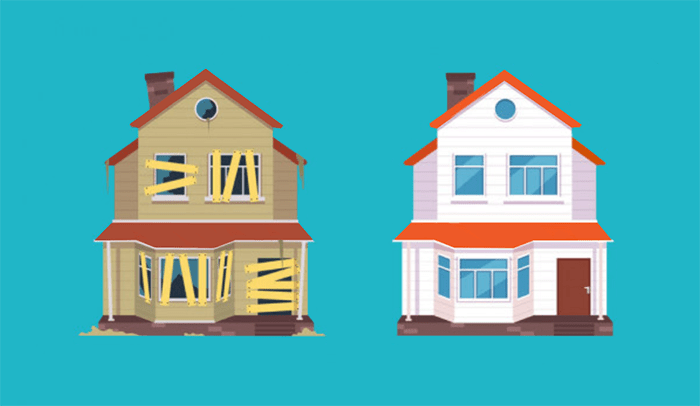I made over $50,000 flipping one house. You’ve probably heard hype-filled headlines like that in the real estate investing space before. And chances are pretty good you’ve gotten e-mails from “gurus” claiming even bigger profits. Yep, I know. They come into my e-mail inbox nearly every day. I get way too many of them, in fact. The difference is that this “hype-filled headline” is actually true.
Hyped Up Real Estate Investing Profit Claim Revealed
Haven’t we all get sick and tired of these kinds of over-hyped headlines from the gurus? I have. So let’s not go down that road. Instead, let’s be perfectly clear: not all of my house flips end up with profits like this. In fact, most of them don’t. Most of them usually net me between $20,000 and $30,000 (not too shabby), but this one was one of the best ones I’ve done so far — although still not the best. In fact, about 14 months before this one I had what I would consider a “failure” where I made a profit of only $14,015.
But I’ll save that one for another post. Until then, let’s get into this one, the one that I now affectionately refer to as “The Home Run.”
The Home Run: Behind The Numbers
Many real estate investors claim that you shouldn’t use wholesalers. I found this deal through a real estate wholesaler, so that should be enough to quiet the critics. In fact, even though I had to pay him a $5,000 commission, it still was a home run. So, if anyone tells you that you can’t make money flipping houses while using wholesalers, don’t listen to them. This blog has outlined some of the many benefits of using wholesalers in real estate investing, so there’s no need for me to get into that right now. Let’s just get right into the really good stuff.
Here are the vital stats:
- Where: Wareham (Onset), MA
- Type of house: 3 Bedroom, 2 bath cape style
- ARV (after repair value): $209,000
- 70% Rule: $209,000 x 70% = $146,300
- Projected profit at 20%: $41,800
- Projected other expenses at 10%: $20,900 (including closing costs, attorney fees, real estate commissions, and financing interest)
- Estimated Repairs: $90,150
- MAO (maximum allowed offer): $56,150
- Financing: No Money
On this flip, I didn’t use any money of my own. As I’ve talked about here before, it is possible to flip houses with no money. And this flip is proof positive that it can be done. Of course, the money has to come from somewhere (it’s not like you actually flip it for free), you’re just using other people’s money or “OPM”, instead of your own.
Flipping Houses
In most cases, especially if you’re new to flipping houses, you may not be able to flip a house without any money of your own, especially if you’re using private moneylenders. They usually do want you to have some skin in the game. However, the more you do it, the better your relationships become with your lenders. Even though I did use a hard money lender for this deal, I have a very good relationship with him. He knows that I’ve done plenty of other flips, and I’ve gotten him consistently good returns. So he gave me preferred lending rates.
This is one of the real benefits of having a successful track record, as well as one of the benefits of networking and building solid relationships when investing in real estate. For this reason alone, if you’re first starting out, don’t discount hard moneylenders. I use them all the time on my flips.
From the profits that you see here, this flip would still be a “home run” even if I had used “traditional” hard moneylender terms. Hard money lenders can definitely get you into deals, and you can still turn a profit with them as long as you follow all the other rules like the 70% rule, sticking to your MAO, and using highly accurate ARVs.
The Home Run: What Went Right
I think it goes without saying that there were a number of things that went right on this house flip. The market did get just a bit hotter during the six months between initial purchase and final sale, but not much. Even without market-based price appreciation, I still would’ve made a pretty nice profit on this one.
It’s “the system” that made me the big profit…not the market.
But “the pluses” on this deal far outweighed “the minuses” as you can see:
- Although my MAO was $56,150, I paid $48,000. So immediately I was + $8,150
- My cost of repairs was projected at $90,150, but came in at $104,668, making me a – $14,518
- Other expenses were projected on $20,900, but they actually came in at $22,697, so there I was – $1,797
- And lastly, and perhaps best of all my ARV was projected at 209,000, but we ended up selling it for $231,500, making me + $22,500
- Total upside over projection: +$14,335
- Projected profit was $41,800, but we were + $14,335
- Netting +$56,135 before taxes
Although most of the factors in this flip were positive, the only cost overruns were on the repairs. This was primarily due to some extra-unexpected framing repairs we had to do to make the space behind the walls as beautiful as the space in front of the walls.
Although these were additional framing details we probably didn’t need to do, I’m not in this business to “put lipstick on a pig.” If we know that there’s something we need to do, even if we know that we could probably “get away with it” at the inspection, my house flipping team is committed to doing the right thing. We do responsible rehabbing, period. No exceptions.








